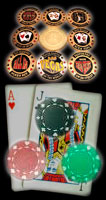OVERPAIRS
Before I finish this chapter, I want to look at one more example situation.
Let’s look at everybody’s favorite hand, a pocket pair of Aces when the flop looks a little scary.
Suppose you have A ![]() A
A ![]() , and the flop is 10
, and the flop is 10 ![]() 9
9 ![]() 6
6 ![]() .
.
This is not the flop you wanted to see with your pair of Aces.
The betting iplied odds are that you’ve got the best hand, but with this flop you can’t be sure.
If you’re not best, then it’s going to be expensive for you, and even if you are best, there are a lot of cards that can fall on the next two rounds that will beat yours.
It’s not a good situation. So what should you do?
In most cases you should play this very aggressively. You should almost always bet or raise if someone else has bet first.
You should almost never slow play in this kind of situation. Giving a free card, or a cheap card, can be a disaster here.
You probably have the best hand, and you should bet or raise to cut down on the odds that the probable playing draws are getting.
If the field is small, only one or two other active hands, then you should be particularly aggressive. Do not just bet and raise, but put in the last bet.
Even many passive players will raise with a flop like this if they have a decent draw, but if there are only one or two callers, they probably are not getting the right odds to be raising against your overpair.
Reraise. There is one exception to this.
That’s when the game conditions are very loose and very aggressive.
In that case you should still bet and raise if someone else has bet first, but if you bet and are raised, you should probably not reraise.
The reason for this is that if there are four or five active poker drawing hands, the collective draws they have are likely to put your overpair at a disadvantage to the field.
Against an aggressive field, the chance of being reraised by very good draws is just too large to risk putting in extra bets.
This is example where you should almost always play the hand the same way. Bet it, raise it, raise it.
The only exception is that you should slow down if it’s a very loose and very aggressive table and you are raised.
In this example it’s not as important to think in terms of what kinds of hands the other players are likely to play poker game as it is important to think of how they are likely to play those hands.
Pick the Right Table / Picking a Seat / Theories of Poker / Betting Theory: The Odds
A Theory of Starting Hand Value
A Theory of Flop Play: Counting Outs and Evaluating Draws
The Dynamics of Game Conditions / Table Image / Player Stereotypes
Women and Poker / Spread-Limit Games / Double Bet on the End Games / Kill Games
Short-handed Games / Tournaments / No-limit and Pot-Limit Poker



